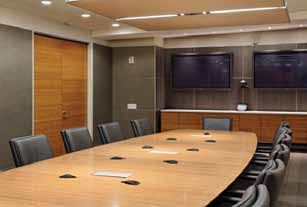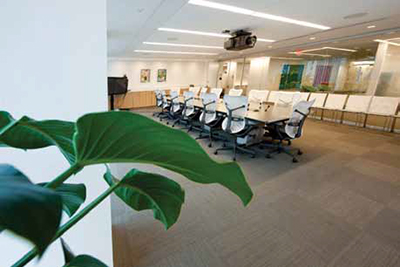- In the audiovisual world, we are continually looking for ways to grow and expand our business. We look to all the usual ways, the new projection system, better speakers, maybe an additional control system to spice up your product offerings.
Lighting control such as that incorporated into the Crestron system designed by Cerami and Associates and integrated by Robert Slye Electronics at The World Bank in Washington, DC, is key to “an integrated technology solution for the entire building,” noted Claudia Barbiero of Crestron. This allows clients “to maximize productivity, efficiency, energy savings, and reduce operational costs.”
As dealers we are constantly called or visited, maybe even harassed, by our distributors, reps, and even our manufactures to get on board with this latest product and that greatest product. Everything is of course designed to grow and expand our business. Sometimes it works, and that new product allows your company to reach a whole new client base who all have the deepest pockets, but that’s not the most common outcome.
Usually what happens when you succumb to that rep call and you add that new product line is that you end up with another speaker series, for example, that never exactly lives up to those expectations, and doesn’t introduce you to that new client base with those deep pockets. It just becomes another product with a logo that sits on your website beside your other product logos, hopefully bringing in a couple new clients. Maybe this helps your business a little bit. But what if there was another avenue to allow you to expand your business?
What we hear in every business development course, and almost every InfoComm class, is that we need to differentiate; we need to find recurring revenue. I could go on and on, but it’s true, you do need to differentiate, you need to find recurring revenue. This is where lighting control comes in. Lighting is that amazing value-added extra that shouldn’t be an extra; it should be part of the foundation. Lighting should be a core component in every project on which you work.
As we all tout the power of automation and the ease of use that technology should provide for our clients and end users, we should be able to see how easy a sell lighting control really is when we are providing such custom audiovisual solutions. It just fits, especially in a time when our clients are asking us to help them achieve a level of duplicity within their systems, such as requiring that the boardroom which is normally used for meetings also be able to function seamlessly for presentation and videoconferencing.
By utilizing lighting control systems from companies like Lutron as a key component of your audiovisual solution, you are allowing your client that flexibility to create the perfect setting for however they plan to use their space. “Adding Lutron lighting controls, fixtures, and automated shades provides complete control of both natural and electric light to produce the perfect setting for the multiple requirements of any space,” observed Christina Magee, lead research and qualification analyst at Lutron.

The Lutron Quantum total light management system with Hyperion Solar-adaptive Shading controls lights and Lutron automated shades throughout SAP America’s new building, dramatically reducing lighting energy usage, and helping the company earn LEED credits.As green building and energy efficiency continues to dominate the minds of builders and our clients alike, we need to jump on this trend and own it. Whereas in the past, you may have attempted to sell lighting control strictly on its light level setting prowess (which is amazing by the way), today you can sell lighting control on its automation powers. Well-designed lighting control systems can function with time clock events as well as occupancy/vacancy sensors to provide an unforeseen level of automation to your clients. When you see these sensors and their system counterparts as able to integrate with other third-party building technology management systems, you can provide your clients with managed solutions that interface with room schedules provided by Microsoft Exchange and other scheduling applications.
As we continue to see more and more projects that focus on enterprise-wide solutions versus the single room approach, it is key to provide complete solutions. Our customers expect our solutions to not only encompass traditional AV but also to include other types of integrated technologies like lighting control to allow our customers to maximize their energy efficiency and operating cost savings.
Today, you should not only focus on providing lighting control for the regular and expected spaces like meeting rooms, ballrooms, lobbies, restaurants, and the like, but also include control of hallways, offices, stairwells, guestrooms, etc. By controlling the lighting in more spaces, you are providing a more complete solution, all while allowing you client to be much more energy efficient throughout their businesses.
As your solutions expand to provide more AV integration, and specifically more lighting control into more spaces, you will need to provide solutions that integrate with building management systems to a greater extent. “Customers expect manufacturers to provide more than just an ‘AV’ solution,” noted Claudia Barbiero, solutions marketing manager, lighting control and energy management at Crestron. “They require an integrated technology solution for the entire building to maximize productivity, efficiency, energy savings, and reduce operational costs.”
As this new year has dawned, we are seeing more indicators of how important lighting control is, and you should be glowing at the opportunities that are presenting themselves. Take for example some of the regulations (ASHR AE 90.1-2010) that have come down in the U.S., which require local building codes to incorporate daylight harvesting and occupancy/vacancy sensing into commercial spaces. Not to mention that lighting design layouts for AV-equipped rooms must also incorporate energy-saving lighting controls like sensors in addition to the old favorites like the “AV Dim” keypad scene, dimming the lights and dropping the shades on a presenter during a boardroom presentation so everyone can proceed to doze off through it.
Although regulations like these will continue to push lighting control to the forefront, there are other factors that will play a part. We will continue to see a large desire for products that are easily retrofitted into existing installations. A large portion of lighting control products are centered around the retrofit market, including a large number of wireless lighting control products available to dealers today. Retrofitting products are a requirement on numerous projects where new cabling isn’t a possibility, and can’t be pulled due to building or tenant restrictions.
You can no longer sit back and ignore the ever-expanding lighting control market just because you don’t want to pull some wires—the retrofit product availability for companies Lutron, Crestron, AMX, and the like opens all kinds of new opportunities in the lighting control market. “Operating expenses in building can be reduced through energy-efficient retrofitting, so wireless systems are a perfect solution,” said Doug Hall, sernior product manager at AMX.
This all points to the fact that lighting control is really becoming an integral part of not only the AV solution that you provide to your clients, but also their facilities management plan and cost reduction plans. Now you’ve not only provided a wonderful solution that meets the needs of your clients’ AV requirements—you’ve also positively affected your clients’ bottom line.
You’ve done all this by doing one little thing for your business (it’s actually not a little thing, it’s a very big deal). You’ve added lighting control to your business. You’ve gone ahead and added something that affects every room you’ll ever be in. It affects the big presentation room that you’re providing a top-notch AV solution for, but it also affects the hallway outside, the lobby, and oh yeah, even the CEO’s office. Your matrix switch can’t do that! Lighting control can! So dive in and paint that space in the right light and watch your business expand as you touch more spaces with the awesome power of lighting control.
Matt D. Scott (mds@omegaaudio.net) is the president and founder of OMEGA Audio Video, in London, Ontario, Canada. Scott had his first encounter with pro-audio at age six, when a PA loudspeaker fell, cracking his head, and leaving a scar to this day. Scott has been working in pro AV, commercial AV, and residential AV ever since. A self-professed tech-head, Scott shares his opinions on social media, local radio, omegaaudiovideo.com, mattdscott.com, and through various publications.












